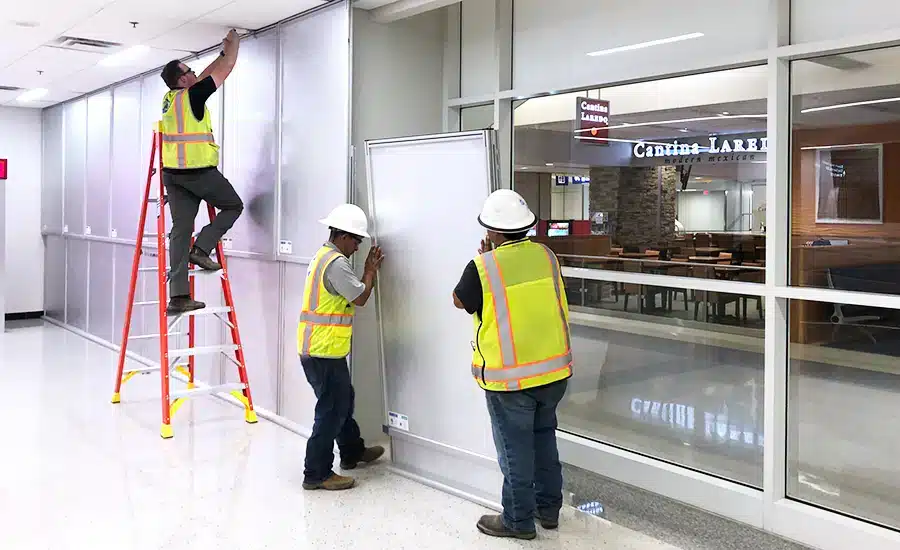
Renovation work is evolving fast. Rising sustainability expectations, tighter labor capacity, and greater pressure to minimize disruption in occupied spaces are reshaping how construction teams plan and execute projects. Instead of relying on linear workflows that create excess waste and slow schedules, builders are turning to smarter jobsite practices that support efficiency, safety, and environmental responsibility.
Across healthcare, commercial interiors, airports, and tenant improvement projects, three renovation-focused trends stand out: the shift toward low-waste, repeatable renovation methods; sustainability decisions beginning earlier in the construction process; and a stronger emphasis on efficiency as labor shortages persist.
Below, we explore each trend—and how STARC’s reusable temporary wall systems help teams contain dust, noise, and debris while keeping projects on schedule.
1. Smarter, Low‑Waste Renovation Practices Are Becoming Standard
Renovation teams are increasingly adopting workflows that reduce waste, minimize disruption, and streamline phasing. Whether in hospitals, active airport terminals, or fully occupied office spaces, the priority is clear: keep people safe, keep operations running, and keep the project moving.
Several forces are driving this shift:
- Faster phasing: Occupied renovations require methods that minimize downtime and avoid shutting down critical areas.
- Cleaner jobsites: Owners expect visible cleanliness and clear plans to limit dust, noise, and debris.
- Material efficiency: Teams are reducing waste by choosing reusable systems over single‑use materials.
This trend is not tied to a single construction method. Instead, it reflects an industry‑wide effort to make construction and renovation more predictable, sustainable, and disruption‑free. Standardizing tools that install quickly, can be reused across multiple sites, and adapt to changing field conditions is becoming a hallmark of efficient project delivery.
2. Sustainability Now Starts at the Construction Phase
Sustainability used to be considered near the end of a project. Today, it begins on day one—at the trailer and on the jobsite.
Owners and regulators are evaluating the full lifecycle of construction materials and processes. That means project teams are now expected to think beyond immediate performance and consider long‑term environmental impact.
Three shifts are leading the way:
- Material scrutiny: Low‑VOC options, reusable panels, and low‑carbon materials are replacing jobsite staples.
- Lifecycle thinking: Teams are prioritizing solutions that reduce waste at close‑out and can be redeployed on future jobs.
- Owner demand: Sustainability now influences bid competitiveness across both public and private sectors.
This is especially important in healthcare, airports, and tenant‑occupied renovations—environments where a clean, quiet, well‑contained jobsite reflects directly on the owner’s reputation.
3. Efficiency Is the New Urgency
Labor capacity remains a defining challenge in construction. According to recent McKinsey analysis (June 2024), the United States had 1.5 million fewer unemployed workers than available jobs, and construction continues to face persistent skill bottlenecks.
As a result, project teams are prioritizing tools and workflows that maximize productivity without increasing complexity:
- Fast‑install systems
- Solutions that reduce training time and require minimal specialty tools
- Products that limit rework and support agile field changes
Temporary solutions like dust and noise barriers have historically been an afterthought, but today they play a central role in clean‑build protocols and efficient phasing. In environments where work cannot slow down, these systems must support progress—not hinder it.
How STARC Helps: Reusable Systems That Support Green, Lean, Fast Construction
STARC’s reusable temporary wall systems are designed for the realities of modern renovation. Whether teams are working in healthcare, airports, commercial interiors, or data centers, STARC helps crews contain dust, noise, and debris while maintaining speed, compliance, and a professional appearance.
Here’s how STARC aligns with today’s construction priorities:
- Greener: Reusable for years and hundreds of installs, STARC panels drastically reduce landfill waste compared to single‑use drywall.
- Leaner: Crews can install 100 feet of wall in under an hour—a performance benchmark confirmed across healthcare renovations, airport upgrades, and tenant improvements. The speed allows teams to reallocate skilled labor to higher‑value work.
- Faster: Lift‑and‑drop connections minimize training needs and make it easy to adjust layouts as project requirements evolve.
STARC temporary wall systems exceed ICRA Class IV and V guidelines, support negative‑air integration, and deliver a clean, finished‑wall appearance that helps protect both the builder’s and the owner’s reputations.
FAQ: Greener, Leaner, Faster Construction
A: Smarter renovation practices, embodied carbon reduction, and leaner workflows are shaping modern, sustainable building practices.
A: Not at all. Modular and prefabricated elements can accelerate renovations, support phasing, and reduce disruption in healthcare, retail, and commercial interiors.
A: Unlike drywall, which is discarded after each project, reusable wall systems can be used for hundreds of installs. This reduces waste, supports landfill‑diversion goals, and aligns with circular‑construction strategies.
A: Yes. Systems like STARC’s exceed ICRA, fire safety, and building code requirements while keeping teams productive.
A: Intuitive, tool‑lite systems reduce training time and allow skilled labor to focus on complex tasks—critical when crews are stretched thin.
Conclusion: Sustainability Is No Longer a Tradeoff
Green. Lean. Fast. These are not competing goals—they’re the new baseline. Owners expect sustainable, well‑contained renovations that stay on schedule, and construction teams are meeting that challenge with reusable systems and efficiency‑first workflows.
The shift is already underway. The builders who adopt smarter renovation practices and stronger material strategies will be positioned to lead the next decade of high‑performance construction. STARC is proud to help teams contain dust, noise, and debris while delivering cleaner, safer renovations that minimize disruption to people, schedules, and facilities.
Ready to build greener, leaner, and faster? Explore how reusable, high-performance wall systems help project teams stay compliant, reduce waste, and keep construction moving without disruption. See how STARC supports your next project.
